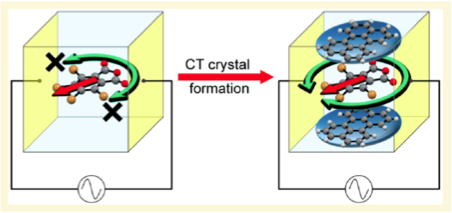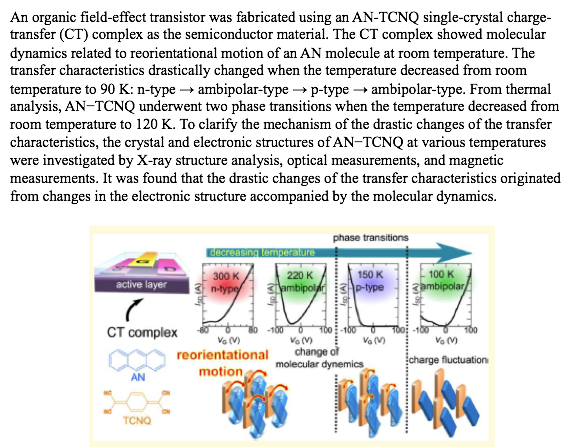


“Switching of Transfer Characteristics of an Organic Field-Effect Transistor by Phase Transitions: Sensitive Response to Molecular Dynamics and Charge Fluctuation”
S. Yokokura, Y. Takahashi, H. Nonaka, H. Hasegawa, J. Harada, T. Inabe, R. Kumai, H. Okamoto, M. M. Matsushita and K. Awaga
Chem. Mater., 27, 4441-4449 (2015), DOI: 10.1021/acs.chemmater.5b01383


“Molecular Motion, Dielectric Response, and Phase Transition of Charge-Transfer Crystals: Acquired Dynamic and Dielectric Properties of Polar Molecules in Crystals”
J. Harada, M. Ohtani, Y. Takahashi and T. Inabe
J. Am. Chem. Soc. 137, 4477-4486 (2015), DOI: 10.1021/jacs.5b00412
D-1: Molecular Motion in Charge-Transfer Complexes and Ferroelectricity
It is well known that molecular rotational motion can occur in molecular crystals. Spherical molecules undergo isotropic rotation in their plastic crystal phase. On the other hand, disc-shaped molecules such as aromatic hydrocarbons may undergo in-plane rotational motion. However, in their single component crystals, such motion is not favorable since the molecules pack tightly in the crystalline phase. This situation can be modified in their molecular complexes, especially when the charge-transfer interaction is weak. Donors and acceptors in such complexes are required to crystallize in mixed-stack columnar structure which allows the components to rotate due to relatively loose packing. If the component has a dipole moment, the polarity of the crystal arising from the net alignment of the moments may respond to external electric fields, resulting in ferroelectricity.
In our study, CT complexes composed of polar donors and acceptors are designed, and their structures are investigated using X-ray diffraction, aiming at novel organic dielectric materials.
Molecules in crystals often suffer from severe limitations on their dynamic processes, especially on those involving large structural changes. Crystalline compounds, therefore, usually fail to realize their potential as dielectric materials even when they have large dipole moments. To enable polar molecules to undergo dynamic processes and to provide their crystals with dielectric properties, weakly bound charge-transfer (CT) complex crystals have been exploited as a molecular architecture where the constituent polar molecules have some freedom of dynamic processes, which contribute to the dielectric properties of the crystals. Several CT crystals of polar tetrabromophthalic anhydride (TBPA) molecules were prepared using TBPA as an electron acceptor and aromatic hydrocarbons, such as coronene and perylene, as electron donors. The crystal structures and dielectric properties of the CT crystals as well as the single-component crystal of TBPA were investigated at various temperatures. Molecular reorientation of TBPA molecules did not occur in the single-component crystal, and the crystal did not show a dielectric response due to orientational polarization. We have found that the CT crystal formation provides a simple and versatile method to develop molecular dielectrics, revealing that the molecular dynamics of the TBPA molecules and the dielectric property of their crystals were greatly changed in CT crystals. The TBPA molecules underwent rapid in-plane reorientations in their CT crystals, which exhibited marked dielectric responses arising from the molecular motion. An order−disorder phase transition was observed for one of the CT crystals, which resulted in an abrupt change in the dielectric constant at the transition temperature.
